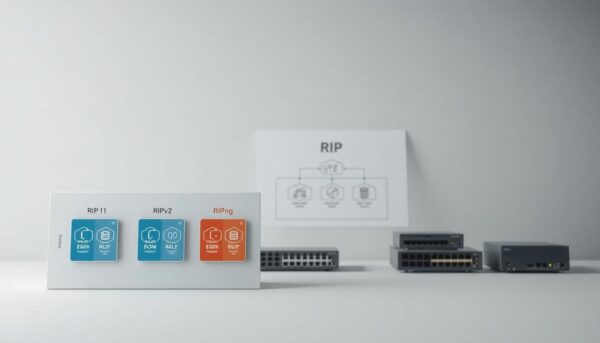✅ Last checked on
Ever wondered how data packets find their way through the internet? The Routing Information Protocol (RIP) is a key player in this journey. It’s a distance-vector routing protocol that has been around for a long time. But why is it still important in today’s fast networks?
RIP has been guiding data across networks since the early days of the internet. It uses a simple method to find the best path for data. This method is based on how many hops it takes to get from one point to another. RIP is still important in smaller networks where simplicity is key.
RIP works by routers sharing their network knowledge with their neighbors. This helps the network adapt and find the best routes. But how does it do this with just a simple hop count metric?
RIP’s lasting impact in networking shows its reliability and ease of use. Even though newer protocols are more complex, RIP’s simplicity is still valuable. It’s great for small to medium-sized networks and for learning about network routing.
Key Takeaways
- RIP is one of the oldest distance-vector routing protocols
- It uses hop count as its primary metric for route selection
- RIP is still relevant for small to medium-sized networks
- The protocol has a maximum hop count of 15
- RIP sends routing table updates every 30 seconds
- It’s an excellent tool for learning basic routing concepts
Understanding Distance Vector Routing Fundamentals
Distance vector routing is key in many network protocols, like the Routing Information Protocol (RIP). It has been important for network communication since 1969, when it was first used in ARPANET and CYCLADES.
What is Distance Vector Routing?
Distance vector routing helps routers find the best path for data packets. It uses a simple rule: hop count. Each router keeps a routing table that shows how far each network destination is.
Core Components of Distance Vector Protocols
The main parts of distance vector routing are:
- Routing tables
- Update mechanisms
- Path calculation algorithms
RIPv1 routers send out their routing tables every 30 seconds. The Bellman-Ford algorithm finds the best routes based on this info.
The Role of Hop Count in Routing
Hop count is very important in distance vector routing. It shows how many routers a packet goes through to get to its destination. RIP uses hop count as its main measure, with a limit of 15 hops to avoid loops.
Even though distance vector routing is simple, it has its challenges. Slow updates and the risk of loops are big issues. But, techniques like split horizon and poison reverse help make networks more reliable.
RIP Protocol Overview and Architecture
The Routing Information Protocol (RIP) is a distance vector routing protocol for small to medium-sized networks. It picks the best path for data packets based on hop count. Let’s dive into how RIP works, its versions, and key features.
Basic Operation and Functionality
RIP shares routing info between routers every 30 seconds. This keeps the network map up to date. It only goes up to 15 hops, and anything beyond is unreachable.
- RIP uses UDP port 520 for communication
- Routers remove destinations from routing tables after 180 seconds of inactivity
- Each update message can contain up to 25 destinations
Protocol Versions and Evolution
RIP has grown through several versions to get better. The main versions are:
| Version | Features | Compatibility |
|---|---|---|
| RIPv1 | Basic functionality, no subnet support | IPv4 |
| RIPv2 | Subnet support, authentication | IPv4 |
| RIPng | Designed for IPv6 networks | IPv6 |
Key Features and Characteristics
RIP uses several methods to improve its performance:
- Split horizon: Reduces unnecessary routing traffic
- Poison reverse: Advertises unreachable routes with a hop count of 16
- Bellman-Ford algorithm: Used for route calculation

While RIP is easy to set up, it struggles with large networks. Its need for regular updates can slow down how quickly the network adapts, mainly in big networks with lots of routers.
How RIP Functions in Network Environments
RIP is key in managing network traffic and keeping routing info up to date. This section dives into how RIP works, focusing on finding routes, updating info, and managing routing tables.
Route Discovery Process
When a RIP-enabled router joins a network, it starts the route discovery process. It sends out a request for routing info to its neighbors. Neighboring routers then share their RIP routing tables.
This exchange helps the new router build its own routing table. It learns about network destinations and their metrics.
Update Mechanisms and Timing
RIP updates happen every 30 seconds. In this time, routers broadcast their entire routing tables to neighbors. This keeps all routers’ info current.

Routing Table Management
RIP routers manage their tables based on update info. Each route includes the destination network, next-hop router, and hop count. RIP uses hop count as its metric, with a max of 15 hops.
Any destination beyond 15 hops is unreachable. To avoid loops, RIP uses split horizon and route poisoning.
- Split horizon: Stops a router from advertising routes back to the interface they were learned from
- Route poisoning: Marks routes as unreachable when a link fails, stopping other routers from using bad paths
These methods keep RIP routing tables accurate and ensure packets are forwarded efficiently. By understanding RIP, network admins can better manage it in their networks.
Implementation and Configuration
To set up RIP in your network, follow a few key steps. First, access your router’s command-line interface. Then, use the command ‘router rip’ to start the protocol.
After that, tell RIP which networks to include in its updates. Use the ‘network’ command followed by the network address. For instance, ‘network 10.0.0.0’ includes all subnets of the 10.0.0.0 network. Remember, RIP uses classful routing by default, so knowing your network’s structure is important.
When setting up your network, think about adjusting RIP timers for better performance. The default update interval is 30 seconds. You can change this with the ‘timers basic’ command. Here’s a typical timer setup:
| Timer | Default (seconds) | Recommended (seconds) |
|---|---|---|
| Update | 30 | 5 |
| Invalid | 180 | 15 |
| Holddown | 180 | 15 |
| Flush | 240 | 30 |
When setting up your home office network, keep in mind RIP’s limits. It’s great for small networks with a maximum hop count of 16. For bigger networks, you might need other routing protocols.
Lastly, remember to secure your RIP updates. Enable authentication to keep them safe from unauthorized access. Use the ‘key chain’ command to set up authentication keys, making your router setup more secure.
RIP Protocol Timers and Operations
RIP timers are key to keeping routing info up to date and avoiding loops. They work together to keep the Routing Information Protocol running smoothly.
Update Timer Operations
The update timer decides how often RIP routers share their routing tables. RIPv1 routers update every 30 seconds, with a random delay to avoid congestion. This means updates happen every 25 to 35 seconds.
Invalid and Holddown Timers
The invalid timer is set at 180 seconds. If a router misses an update for a route in this time, it flags the route as invalid. The holddown timer, also 180 seconds, helps stabilize routes by preventing new info on recently invalid routes.
Flush Timer Management
The flush timer is 240 seconds. It decides when an unreachable route is removed from the table. It’s 60 seconds longer than the invalid timer, giving RIP time to notify neighbors before removing routes.
| Timer | Duration (seconds) | Function |
|---|---|---|
| Update | 30 | Interval between routing updates |
| Invalid | 180 | Time before route is marked invalid |
| Holddown | 180 | Prevents acceptance of new route information |
| Flush | 240 | Time before route is removed from table |
Knowing about RIP timers is crucial for network admins to improve RIP’s performance and keep networks stable. By tweaking these timers, you can tailor RIP to your network’s needs.
Advantages and Limitations of RIP
RIP is a distance-vector routing protocol with its own set of benefits and drawbacks. Knowing these can help you decide if RIP is right for your network.
Benefits in Small Networks
RIP is great for small to medium-sized networks. It’s simple to set up and manage. RIP updates every 30 seconds, keeping all routers in the loop. It also works with almost all router brands, making it versatile.
Scalability Challenges
RIP has trouble scaling with larger networks. It has a maximum hop count of 15, which can cause unreachable destinations. Its updates can also use up a lot of bandwidth in big networks. These issues make RIP less good for complex networks.
Security Considerations
Security is a big worry with RIP. Its slow updates can cause routing loops and make networks vulnerable. RIP uses split horizon and route poisoning to avoid loops, but these aren’t perfect in changing environments.
| Feature | RIP Advantages | RIP Limitations |
|---|---|---|
| Configuration | Simple setup | Limited options for complex networks |
| Network Size | Ideal for small to medium networks | Struggles with large networks |
| Update Frequency | Regular updates (every 30 seconds) | Can cause bandwidth issues |
| Hop Count Limit | Prevents routing loops | Maximum of 15 hops |
| Convergence Speed | Adequate for stable networks | Slower than OSPF or EIGRP |
Conclusion
RIP implementation is still talked about in the world of network routing protocols. It’s not the first choice for most networks today. But, RIP is still useful in some cases.
Its simplicity and easy setup make it great for small networks or learning places.
When you compare RIP to other protocols, you see its limits. Protocols like EIGRP, OSPF, and IS-IS do better in big, complex networks. They converge faster and handle growth better.
Think about using RIP for simple setups. For more complex needs, look at other protocols. Knowing RIP’s good and bad points helps you choose the right protocol for your network.